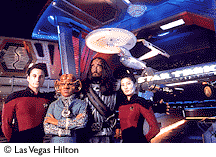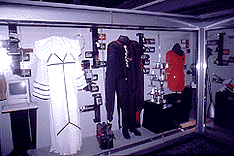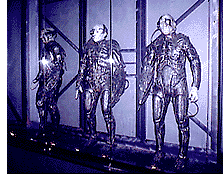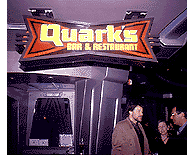| |

Star
Trek: The Experience
Boldly
Go Where No Thrillseeker Has Gone Before.
These days,
there's a buzz word floatin' around the amusement industry that
I'll bet you've heard more than once: Immersive. Talk to
any ride designer, show producer or park developer about the next
generation of theme park attractions and this potent adjective
will almost invariably enter the conversation. "Immersive"
has become a three-syllable mantra for anyone striving to create
the kind of experience that puts you, the sophisticated Thrillseeker,
right into the center of the action.
The goal of an immersive attraction is to develop a captivating
story and tell it four-dimensionally, as fully realized as possible,
with the paying guest as a major participant. Think Back To
The Future: The Ride, Alien Encounter or Terminator
2:3-D - these are some of the first, best examples of what
we're talking about. To really pull off this kinda thing, you
need two key ingredients: major pools of talent and bushels of
cash, a rare combination. Until recently, Disney and Universal
were practically the only two forces capable of delivering something
you could happily call "immersive."
Not anymore. Paramount Parks, the Las Vegas Hilton and Landmark Entertainment Group have combined their considerable
resources to create The New Standard in immersive entertainment.
And it's called Star Trek: The Experience(TM).

. . . . . . . . . . . . . . . . . . . . . . . .
  Based at the Las Vegas Hilton, this $70 million, 65,000 square-foot museum
/ show / thrill ride / restaurant / bar / shopping emporium is
the culmination of nearly four years of development. Four years
may seem like an awfully long time to devote to such a project,
but wait'll you discover what that gargantuan effort has produced. Based at the Las Vegas Hilton, this $70 million, 65,000 square-foot museum
/ show / thrill ride / restaurant / bar / shopping emporium is
the culmination of nearly four years of development. Four years
may seem like an awfully long time to devote to such a project,
but wait'll you discover what that gargantuan effort has produced.
The entrance to the ST:TE complex is found at the rear of the
hotel's new SpaceQuest casino. Step through this room's
glowing portals and you'll find yourself inside a 24th century
space craft, floating high above Mother Earth. Even if you're
not into gaming, you'll love the casino's wild sci-fi design -
crackling red and blue neon lights, massive steel supports, overhead
catwalks and three humungous "windows" that look out
at the starlit heavens. If you stare long enough, watching the
planets and the neighboring spaceships float by, you might get
a bit woozy - it's a pretty nifty effect. And, guys, you gotta make a quick stop in a SpaceQuest rest room. I won't ruin
the fun by saying anything more, other than to tell you that those
facilities boast the most hysterically high-tech urinals to be
found anywhere.
For those of you who do enjoy the occasional wager, you're
gonna be mighty tempted by the hopelessly cool blackjack tables,
roulette wheels and assorted slot machines. Even the croupiers
are dressed to the Nines in futuristic garb. But press on towards
that majestic model of the Enterprise you see beckoning up ahead.

 Tickets for The Experience are available right alongside the attraction entrance
and if you're looking for the best thrill ride deal in Vegas,
you just found it: $9.95 is all you part with for this twenty-minute-plus
adventure. (Don't get me wrong; I love the Manhattan Express coaster at the New York, New York casino, but a ride on that sucker
costs $5, and it is not half the fun ST:TE is). Tickets for The Experience are available right alongside the attraction entrance
and if you're looking for the best thrill ride deal in Vegas,
you just found it: $9.95 is all you part with for this twenty-minute-plus
adventure. (Don't get me wrong; I love the Manhattan Express coaster at the New York, New York casino, but a ride on that sucker
costs $5, and it is not half the fun ST:TE is).
Of course, if you'd rather bypass the ride/show, you can enter
the Deep Space Nine® Promenade for free to eat, drink
and shop 'til ya drop. But unless a weak heart, a bad back or
a "bun in the oven" forces you to do so, you'd be crazy
to miss out on best half of what The Experience has to offer.
 After passing beneath the ST:TE entrance arch, you'll stroll along a balcony
above the DSN Promenade that houses an exhibit called the History
of the Future. Above our heads, suspended beneath a star-filled
dome, are three tremendous examples of some of Star Trek's notable
vehicles: The Enterprise, The Voyager and a Bird of Prey. On your
left is a staggeringly complex time-line of dates in history relevant
to the Star Trek Universe, beginning as far back as the 17th century
and advancing close to 1,000 years forward. I'm not much of a
Trekker, so most of it was news to me, making it that much more
entertaining. After passing beneath the ST:TE entrance arch, you'll stroll along a balcony
above the DSN Promenade that houses an exhibit called the History
of the Future. Above our heads, suspended beneath a star-filled
dome, are three tremendous examples of some of Star Trek's notable
vehicles: The Enterprise, The Voyager and a Bird of Prey. On your
left is a staggeringly complex time-line of dates in history relevant
to the Star Trek Universe, beginning as far back as the 17th century
and advancing close to 1,000 years forward. I'm not much of a
Trekker, so most of it was news to me, making it that much more
entertaining.
 On your right are glass cases displaying the largest permanent collection
of Star Trek costumes, props, models, and weapons ever assembled.
Among the many items available for perusal are: 23 original costumes
(Captain Janeway's uniform, Lt. Uhura's uniform, etc.), 8 Starship
models, 10 hand-made steel knives and swords (a Klingon bat'leth,
a sword of Kahless, etc.), 12 display heads (including
a Romulan, a Cardassian, a Ferengi and a Symbiont Trill Slug,
whatever the hell that is) and over 100 hand props, things
like phasers, propulsion boots, the Picard Family Album and the
Borg queen skull and spine. On your right are glass cases displaying the largest permanent collection
of Star Trek costumes, props, models, and weapons ever assembled.
Among the many items available for perusal are: 23 original costumes
(Captain Janeway's uniform, Lt. Uhura's uniform, etc.), 8 Starship
models, 10 hand-made steel knives and swords (a Klingon bat'leth,
a sword of Kahless, etc.), 12 display heads (including
a Romulan, a Cardassian, a Ferengi and a Symbiont Trill Slug,
whatever the hell that is) and over 100 hand props, things
like phasers, propulsion boots, the Picard Family Album and the
Borg queen skull and spine.
Not only do we get to gaze at these gnarly artifacts, we also
learn some wild trivia about them. Fer instance: didja know that
the original Klingon belt buckle was just a piece of bubble wrap
painted gold? Or that Dr. McCoy did his medical scanning with
a gussied-up salt shaker? Or that the Klingons of The Next
Generation® and Deep Space Nine drank from wine
goblets used in the 1956 production of The Ten Commandments?
It's Star Trek "edutainment" at its best.
The queue makes a right-hand turn off the balcony and enters an
exhibit-lined corridor devoted to alien culture. Here we get to
have some close encounters with several of our intergalactic neighbors.
Among my personal faves were the three menacing Borg that stand
guard over the final portion of the waiting area. Howdy, fellas!
Just ahead, the adventure begins.

|
WARNING! |
 |
Before reading any further, a caveat: the following passages will
reveal a couple of this attraction's "surprises." I don't
believe that knowledge of what's written here will detract from
your own excursion, but if you'd rather "do" the Star
Trek Experience totally cold, skip ahead to the next section, introduced
with another Starfleet shield.
. . . . .
. . . . . . . . . . . . . . . . . . .
Okay, now
we're ready to get down to business. Separated into a smaller
group, we're ushered into a little anteroom where we watch an
overhead monitor sum up the dramatic 30-plus year history of the Star Trek phenomenon. The heart starts to beat a bit faster.
Two chipper hosts lead us into a humble simulator boarding area,
asking that we form four orderly rows in front of the loading
doors. This dimly lit cell seems pretty drab for something with
a $70 million price tag, but before you start missing that ten
bucks, your attention is grabbed by the instructional video on
the monitors above the ride entrance. It's the usual stuff, no
pregnant women, folks with physical ailments, blah, blah, blah,..
hey, the screen's goin' wonky, there's some static, the image
breaks up...
One of the hosts, a tad frazzled, starts goofin' with a nearby
control panel - "I'm sorry, everyone, we seem to be having
some trouble, please stand by." That whiny voice inside your
head chimes in - "Well, ain't that sweet... they still don't have this thing workin' right - "
Oh, yes they do.
The monitors go dead. Stroboscopic bursts of light explode before
our eyes. The room is plunged into total darkness. A roaring wind
billows around us like a supernatural force.
And then, a mere three seconds later, the lights come back on.
The small chamber we were just standing in, the walls, the monitors,
the ceiling, everything... is gone.
. . . . .
. . . . . . . . . . . . . . . . . . .
 Ladies and gentlemen, boys and girls, we've just been beamed through time
and space to find ourselves on board the Starship Enterprise.
There we are, smack dab in the middle of the Transporter Room,
facing a Starfleet crew member who seems to have expected our
arrival. That's right, the Transporter Room. Ladies and gentlemen, boys and girls, we've just been beamed through time
and space to find ourselves on board the Starship Enterprise.
There we are, smack dab in the middle of the Transporter Room,
facing a Starfleet crew member who seems to have expected our
arrival. That's right, the Transporter Room.
Now, I'll tell ya, if The Experience ended right here, I'd have
gotten more than my money's worth. I know I'm given to hyperbole,
but this "transportation" sequence really does rank
as one of the most intense effects I've ever witnessed; there's
nothing else like it anywhere. And we're just gettin' started.
The crew member who welcomes us aboard explains why we're here.
Seems some nasty Klingons had tried to pull our group through
the space-time continuum into their dastardly grasp, but our 24th
Century protectors intercepted us in the nick of time. Yes, we're
out of immediate danger, but 1) we're still several centuries
and many light-years from home and 2) those craggy-craniumed villians
know we're stranded on the Enterprise. We've got to keep moving.
We trot down one of the star ship's corridors towards the command
center. Take a good look around; even if you're just a casual
fan of The Next Generation, you'll recognize the amazing
detail with which this environment has been crafted. As you pass
by, be sure to read one of the little red doohickeys on the wall
panels - they are reproduced exactly as they appear on the show's
sets and they're pretty darned funny. But don't dawdle, for just
around the corner is the heart and soul of the Enterprise, The
Bridge.
We're instructed to line up at the rear of the room, facing the
viewscreen. Again, this is as real as it gets, a 1-to-1 scale
reproduction of the set: backlit panels, video screens, the works.
The Bridge hums with activity as more crew members (real live
humans, not some herky-jerky robots) go about the business of
piloting a massive space vehicle through the cosmos - very cool.
Yet there is one notable omission: the captain's chair is empty.
And that, my friends, is an integral part of the conundrum we've
found ourselves in. Commander Will Riker and Lt. Commander Geordi
Laforge pop up on the viewscreen to further explain the gravity
of the situation - the Klingons want us, and they want us Bad.
They have a very good reason for seeking our capture, but that's
one plot development I won't reveal. We do learn why it's
absolutely imperative that each and every one of us return safely
back to the 20th Century. Our only shot at doing so will mean
hopping onto a Shuttle and flying through a handy Vortex. The
Turbo Lift awaits!
 We start to descend, but the Klingons, now mighty ticked off, begin a brutal
assault on the Enterprise. We take a nasty hit and the Turbo Lift
begins to free fall. Hang on, everybody! One violent jolt
after another, the Klingons aren't letting up. Lights flicker,
the explosions get louder, things are looking grim. But at the
last second, control is regained and the doors reopen to deposit
us into the Grand Corridor. We start to descend, but the Klingons, now mighty ticked off, begin a brutal
assault on the Enterprise. We take a nasty hit and the Turbo Lift
begins to free fall. Hang on, everybody! One violent jolt
after another, the Klingons aren't letting up. Lights flicker,
the explosions get louder, things are looking grim. But at the
last second, control is regained and the doors reopen to deposit
us into the Grand Corridor.
The Grand Corridor is brand-spankin' new, a part of the Enterprise
that no one's ever seen before, and like they say, it's fairly
grand. But it's just a conduit to the outer doors of the Shuttle
Craft, and that's where we get to line up (for real, this time)
for the voyage home. Good ol' Geordi explains the safety procedures
and the entire left wall of the Craft floats up. Climb in, sit
down, buckle up and ask yourself if you feel lucky - cuz the
odds ain't stacked in your favor.

Fellow Thrillseekers,
the four-minute Shuttle Craft trip is the climax of The Experience,
in every way imaginable. My first flight, I rode in one of the
rear rows, and most certainly, had a great time. But the next
go-round, I managed to end up in the front row, with almost nothing
to clutter up the view forward and above: Yowza, yowza, yowza!
It wouldn't be sporting to let you in on everything, but
you should prepare for space battles galore, a gorgeous dive through
some planetary rings and a trip down the Vegas Strip that no legitimate
tour guide will ever offer. It's not as rough a ride as,
say, Back To The Future, but it's much more sophisticated.
The ST:TE Shuttle Craft is a motion simulator capable of six-axis
movement - surge, sway, heave, pitch, roll and yaw - which
adds up to a catalog of dance steps that no other current ride
simulator can match.
And finally, of course, you do return to the Hilton in one piece.
Simply amazing.
. . . . .
. . . . . . . . . . . . . . . . . . .
  Once you're back on solid ground, you can unwind in the Deep Space Nine
Promenade. This second part of The Experience is tamer, but
no less involving. Calm your nerves with a refreshment from Quark's
Bar and Restaurant (That's Jonathan Frakes, aka Commander
Riker, standing beneath the entrance). The drink list includes
Romulan Ale, Saurian Brandy and a horrifically potent concoction
called the Warp Core Breach. If you're hungry, try one
of my recommendations: Glop on a Stick (which tastes suspiciously
like a corn dog). Once you're back on solid ground, you can unwind in the Deep Space Nine
Promenade. This second part of The Experience is tamer, but
no less involving. Calm your nerves with a refreshment from Quark's
Bar and Restaurant (That's Jonathan Frakes, aka Commander
Riker, standing beneath the entrance). The drink list includes
Romulan Ale, Saurian Brandy and a horrifically potent concoction
called the Warp Core Breach. If you're hungry, try one
of my recommendations: Glop on a Stick (which tastes suspiciously
like a corn dog).
Or, if you want to bring home a prized keepsake, browse through Garak's Clothiers, Zek's Grand Emporium, the Admiral
Collection or Moogie's Trading Post. You can find everything
from Borg water bottles (under $9) to a Klingon High Council wool
jacket ($225). They tell us it's the largest collection of Star
Trek-licensed merchandise to be found anywhere. The Admiral Collection,
in particular, is a shop no die-hard Trekker should pass up.

As one would
expect, it took a veritable army of creative and technical specialists
to bring ST:TE to fruition. Jane Cooper, president and C.E.O.
of Paramount Parks and Dean Harrold, president and C.O.O. of the
Las Vegas Hilton, presided over a tremendous array of talent,
one that included:
Rick Berman - Senior Creative Consultant. Mr. Berman has
been the guiding light behind all things Star Trek since Gene
Roddenberry hired him to produce ST:The Next Generation in 1987. His careful oversight of the attraction storyline and
simulator voyage ensured consistency with the established Star
Trek Universe.
Tim Fisher - Executive Producer. Mr. Fisher has a long
history with Paramount Parks that includes management positions
at both Paramount's Carowinds park in Charlotte, N.C. and Australia's
Wonderland (before Paramount sold that facility in 1987). He rejoined
Paramount Parks in 1995 to oversee the development and construction
of ST:TE.
Anthony Ezparza - Senior Vice President, Design and Entertainment.
Mr. Esparza has had a long career doing this sort of thing, having
gotten his start in 1984 at Landmark Entertainment Group. During
his tenure there, he was the key designer for Jurassic Park:
The Ride and the Ghostbusters Spooktacular, among many other
projects. Since 1995, he's been with Paramount Parks where he
handles design development for all of the company's entertainment
extravaganzas.
Herman Zimmerman - Design Consultant. Over the last decade,
Mr. Zimmerman has been the production designer for all the Star
Trek properties, including ST:TNG, ST:DSN and the last four ST
flicks. His encyclopedic knowledge of the Enterprise's architectural
details is what makes The Experience look so "real."
Rene Echevarria and Ken Biller - Writers. These two fellows
collaborated on the attraction's story. Fans of Deep Space
Nine should recognize Mr. Echevarria's name - he's written
more than 30 episodes for that series. Mr. Biller is a writer/producer
for Star Trek: Voyager and has also penned a few scripts
for The X-Files.
Landmark Entertainment Group - Attraction Designer/Producer.
Landmark is an amusement industry powerhouse that's been the creative
force behind some of the biggest, best theme park attractions
in the world. Any true Thrillseeker will be familiar with the
names of their finest work: Jurassic Park: The Ride, Kongfrontation, Terminator 2: 3-D. Gary Goddard, Landmark's CEO, David Thorton, Senior
VP/Producer and Luc Mayrand, Creative Director, all contributed
their considerable talents to make The Experience come alive.
Next up on Landmark's slate: the Aliens: 3-D attraction
for Everland Park, Yong-In, Korea.
McFadden Systems - Motion Simulator. This outfit has been
shaking things up since 1963, when it was founded to develop products
for the military simulation industry. In the subsequent three
and a half decades, McFadden has become the industry leader in
creating "hydraulic control force loader" simulation
systems, delivering equipment to airframe manufacturers and aerospace
R&D firms around the world.
Electrosonic - Film Projection System. This group helped
design and install the complex film projection system for the
Shuttle Craft simulator theatre. The high-tech equipment includes
the film projector (a Christie Westrex electronic projector for
8-perf, 70mm stock), a 10Kw lamphouse, reeling system, and the
custom-built fisheye lens. Electrosonic is also creating the projection
systems for the upcoming "Adventures of Spiderman 3-D"
mega-thrill ride at Islands of Adventure.
Scenic Technologies - Scenic and Special Effect Production.
A member of the Production Resource Group, Scenic Technologies
handled the manufacture and installation of all the sets and "action
equipment" for The Experience. Between the Transporter Room
and Turbo Lift sequences, they had their work cut out for them.
Fortunately, they've had plenty of experience doing the same sort
of work for theatrical productions, theme parks, trade shows,
hotels, casinos and restaurants all over the country. ST put together
the more than 100 tons of scenery used in the EFX! show
at the MGM Grand Hotel.
Rhythm & Hues Studios - Ridefilm Producer. This production
house creates both live action and computer-generated sequences
for commercials, movies, rides, music videos and games. I can
guarantee that you've seen at least one example of their prolific
output: The Coca-Cola(TM) polar bears; Babe, the talking pig in Babe; effects work in Speed 2 and Batman and
Robin. It took R&H's 75-person staff 13 months to put together the action and effects-packed four minutes of
footage shown during the Shuttle Craft trip.
Mario Kamberg - Film Director. Mr. Kamberg, who directed
the simulator ridefilm, is another visual designer well-versed
in the world of thrill rides. He developed the concept and directed
the film for Universal's Funtastic World of Hanna-Barbera(TM), and is currently working on the Seafari attraction
for the planned Universal theme park in Japan.
. . . .
. . . . . . . . . . . . . . . . . . . .
And
last, but not least, there's the delightful participation of
both Jonathan Frakes and LeVar Burton who reprise
their Next Generation roles with spirited gusto. Oh,
and Patrick Stewart, too. Yes, even Captain Jean-Luc
Picard makes a brief appearance of sorts during the final moments
of this adventure.
Hats off
to all!
Star
Trek: The Experience
- The starfields
presented throughout the Experience contain over 15,000 stars.
- There's
a quarter mile of neon light tubes, a half-mile of flourescent
light tubes and ten miles of audio cable worming through
the Experience.
- It takes
the combined processing power of twenty-two computers (OSD 9000,
Windows and DOS machines) to operate and coordinate the attraction's
many segments.
- Twenty-four
laserdisc players and 28 video monitors and projectors are scattered
throughout the facility.
- The simulator
dome screens are each 60 feet across and weigh more than 4.5
tons apiece.
Star Trek Miscellany
- The first
episode of Star Trek, created by Gene Roddenberry, debuted
September 8, 1966.
- Since then,
the original series has become the single most successful show
in syndication history.
- Between
the 4 series (Star Trek, ST:The Next Generation, ST:Deep
Space Nine, and ST: Voyager(TM)) over 325 hours of Star
Trek programming have been created, with no end in sight.
- Star
Trek: The Next Generation received 11 Emmy Awards during
its 7-year run.
- Eight Star
Trek feature films have been released and a ninth is on
the way for later this year.
- Pocket
Books has published (are you ready for this?) more than 145 works of fiction and non-fiction based on Star Trek,
and in 15 different languages, to boot. Forty of those titles
in the Star Trek novel series have made the New York
Times bestseller list, a feat easy to believe when you consider
that...
- Thirteen Star Trek books are sold every minute in the United
States. Staggering, ain't it?
- Star Trek
conventions are held every weekend of every year, in
at least four different cities.
Top |